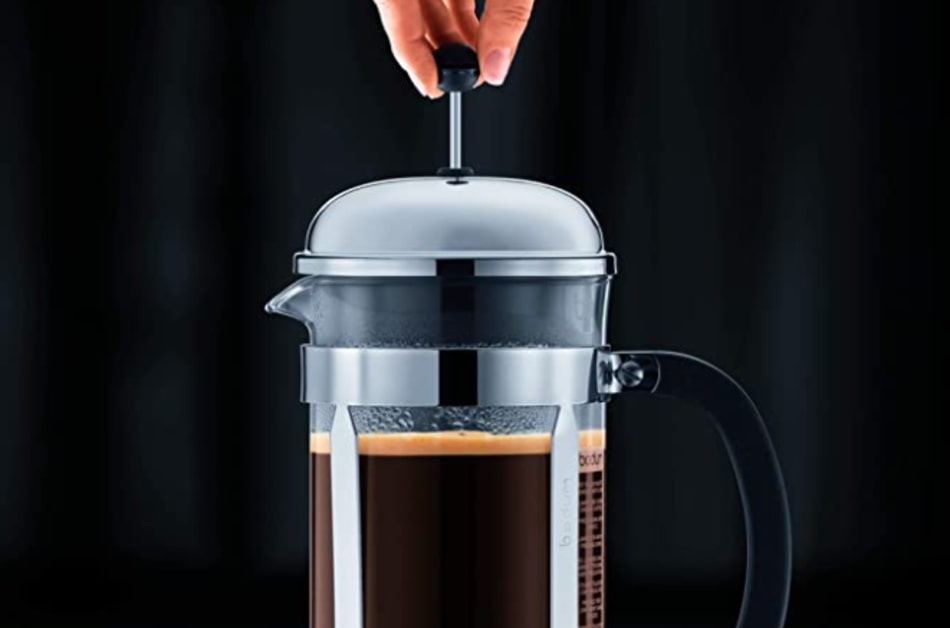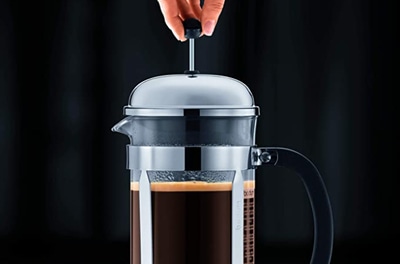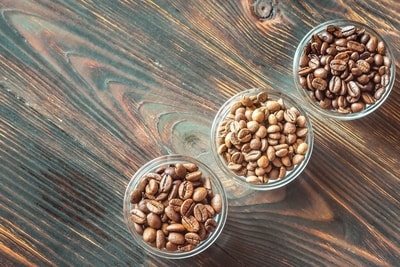The Plastic French Press (That’s Way Better Than Glass)

If you’ve googled plastic French press in the past, you’ll know that there are very few results. Given how easy it is to break a glass French press, it’s surprising that plastic models aren’t more widely available.
I’m going to show you all the advantages of owning a plastic French press, and why I prefer it to glass models.
Advantages of a plastic French press
Whilst a glass French press certainly looks the part, they’re highly prone to shattering. Let’s take an in-depth look at my favourite plastic French press by Bodum (Amazon link).
Unbreakable
I’ve broken my fair share of glass French presses over the years, vowing to never again buy a glass model. For me, the plastic Bodum Chambord French press is a real game-changer as it’s a one-time purchase that’s very affordable.
Not having to worry about the inevitable knock against the side of the sink or one of the kids knocking it over is a great relief.
I admit that my plastic French press isn’t as stylish or elegant as past glass models, but my response to that is: how stylish and elegant is your shattered glass model?
The plastic Bodum Chambord carafe is made from high-quality shatterproof, BPA-free, SAN plastic that’s scratch-resistant, non-deformable by heat, and resistant to temperature changes. That means there’s no more worrying about letting the carafe cool before you clean it.
Even the filtration system of the plastic model by Bodum is superior to its glass-model counterpart. This is yet another reason to convert, but I’ll speak more about that later on.
Portable
What’s great about the plastic French press is the fact that I can take it on the road with me without having to worry.
Whilst the AeroPress is an excellent travel brewer, its size means that it’s really only capable of making coffee for two, perhaps three at a push.
Having a huge 1.5 litre (51fl oz) plastic French press means that everyone can enjoy a delicious cup of hot coffee when we’re out camping. In terms of size, there really is no other brewer that can rival it for trips away from home.
Better heat retention
Another reason I love the plastic French press may seem a little strange. You might be surprised to learn that plastic is actually a more efficient material for brewing coffee than glass is. It has to do with heat retention.
You see, when you add boiling water to a glass carafe, the glass quickly absorbs a large amount of the heat from the water into its walls.
This one often trips people up: it’s common to hear baristas say they prefer [materials other than plastic] ‘because they hold more heat’. However, this is actually a bad thing, as it means it’s taking more heat out of the brew water.
Barista Hustle
Plastic is a very different material. It’s difficult to heat plastic as it takes a lot more energy to do so. This is why you are able to handle plastic coffee makers such as the AeroPress that are filled with boiling water without scalding yourself.
This is excellent news as it means that the water temperature is more stable and better able to extract the coffee, resulting in a superior tasting cup of coffee. It also means that your coffee will stay hotter for longer inside the French press.
Superior filtration
As I touched on earlier, the plastic model has a different style filter. The filter has a silicone edge that doesn’t cause scratches to the interior wall of the plastic carafe.
The silicone material has greater durability and also creates a tighter seal compared to the standard metal filter, meaning that it does a better job of filtering.
The result is a less ‘muddy’ cup of French press coffee. You’ll experience a lot less ground coffee sediment at the bottom of your cup, but it’ll still have the heavy body we all enjoy from French press coffee.
I really don’t understand why Bodum doesn’t use this same filter for all their French press models.
It’s greener than you thought
As we strive to use less and less plastic for the good of our planet, you might feel a little guilty about buying a plastic French press.
But the plastic Bodum press is far from single-use plastic. In fact, it could easily last you a lifetime as there’s no risk of breakages. That’s not likely to be the case for the majority of coffee makers which contain a whole heap of different plastic components.
The French press is, in fact, one of the most environmentally friendly coffee-brewing methods as there’s no need for additional paper filters.
Producing paper has a lot more impact on the planet than people think, and it can sometimes even be comparable to producing plastic.[1]
One concern that many might have is how safe the plastic is in the Bodum French press, so let’s take a look.
Is the plastic safe?
The plastic carafe of the Bodum Chambord states that is BPA-free. But what exactly is BPA and should you be worried?
BPA stands for bisphenol A. BPA is an industrial chemical that has been used to make certain plastics and resins since the 1960s.
BPA is found in polycarbonate plastics and epoxy resins. Polycarbonate plastics are often used in containers that store food and beverages, such as water bottles.
Mayo Clinic
Some research has shown that BPA can seep into food or beverages from containers that are made with BPA. Exposure to BPA is a concern due to the possible health effects that it has on the brain and prostate gland of fetuses, infants and children.
However, the U.S. Food and Drug Administration (FDA) has stated that BPA is safe at very low levels. The good news is that manufacturers, such as Bodum, are creating more and more BPA-free products.
Bodum also states that their carafes are made from SAN plastic. Although I’d heard a lot about BPA, I’d never heard of SAN plastic, so I decided to look into this material.
SAN (and ABS) are high quality plastics that are tough and rigid, and have good temperature and chemical resistance. Although they contain styrene, which is toxic, these kinds of plastics are stable and don’t leach toxins.
Hello Natural Living
Styrene acrylonitrile (SAN) is a type of plastic that usually contains around 70 percent styrene and 30 percent acrylonitrile.
SAN is resistant to boiling water and is often used in place of polystyrene as it provides greater strength, rigidity, and chemical resistance.
For the above reasons, Bodum decided to use this particular type of plastic for their French press, and it’s something I’m personally happy to use on a daily basis.
Alternative French press materials that are unbreakable
If you’re looking for an alternative material for an unbreakable French press, my absolute favourite has to be one made from stainless steel.
Besides its expensive look and excellent portability, stainless steel has several other benefits. Just like plastic, stainless steel absorbs far less heat than glass, meaning that the water temperature remains higher all the way from the initial brewing phase through to enjoying your last sip.
One particular model of stainless steel French press is made by a lesser-known brand called Espro.
The reason that I love my Espro press so much is not only how the double-walled stainless steel keeps the coffee hot for hours but also because of its amazing double-filtration system.
Whilst most standard French press filters only consist of one mesh filter, the Espro has two separate micro-filters (BPA-, BPS- and phthalate-free) that are surrounded by a silicone lip running along the rim.
The lip fits snugly inside the container, creating a vacuum seal. The result is a cup of French press coffee that is really smooth with a lovely body and virtually sediment free.
What’s more, when you press the plunger down, extraction stops immediately, reducing bitterness so that your brew is consistent from the first pour to the last. It can even be used to prepare tea.
I’ve tried my fair share of French presses over the years, and the Bodum and Espro have to be my favourite two French presses out there. So which one are you going to buy?
Check out the current price of the Espro press on Amazon.
Related questions
I have a glass Bodum Chambord, can I just replace it with a plastic carafe?
Yes, you can replace the glass Chambord carafe with the plastic carafe, but you will need to purchase the silicone filtration screen that was specifically designed for the plastic carafe. Using the plastic carafe with a metal-lipped filter will scratch and damage the plastic.







